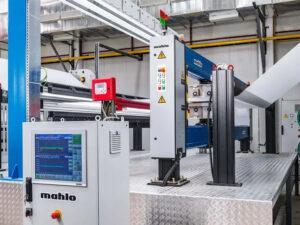Extreme rising in energy prices and a growing uncertainty in almost every industrial sector: many manufacturing textile companies face immense challenges these days. To compete in the market, they must increase the flexibility and efficiency of their production and minimize manufacturing costs by reducing the input of resources. Online quality control in textile production processes is suddenly more important than ever before. German machine builder Mahlo shows, how data-controlled production can solve today’s problems.
“The key points are the correct collection, analysis, and treatment of the right data as well as the seamless transition of data flows between machines, company divisions and to other companies such as customers or suppliers”, says Matthias Wulbeck. He is the product manager for Quality Control Systems (QCS) at Mahlo. The expert also notes that leading industrial companies are thinking ahead as well, producing in a sustainable way before they are forced to, and introduce automated processes and high-tech networked devices to perform live data analysis.
I4.0-compliant Mahlo quality control systems installed throughout a modern textile coating line show the variety of options to control a production. “To adapt to the different needs, Mahlo has a broad portfolio of intelligent scanners and sensors in the Qualiscan QMS system. They record product and process parameters online, such as basis weight, add-on weight, thickness, moisture content, web temperature, residual moisture, exhaust air humidity, air permeability etc. at different stages of the production.”
Processing data in real-time

The measured values are processed directly in the real-time processors of the sensors. The finished measurement data is visualized internally in an intuitive control display or transmitted via interfaces (OPC-UA, Modbus, etc.) to an external network. The implemented automatic control algorithms interact directly with the suitable actuators of the textile coating line and reduce deviation from the target and thus, results in a more uniform end-product. This allows optimized target value specifications and, in addition to better product quality, leads to significant savings in raw materials and energy costs. Furthermore, process reliability and production throughput increase. “And you can react fast and flexible on changing market demands”, Wulbeck adds.
Besides the online control of the above-mentioned parameters, an important function of any quality control system is to provide detailed historical data. By a simplified and direct data exchange, the end user can keep track at any time where and especially how its product is fabricated. With that, not only a trouble-free value chain is guaranteed, according to Wulbeck. The end user can also be sure that its fabric is always produced with the right parameters. “That security in these unsecure times is of high value.”












